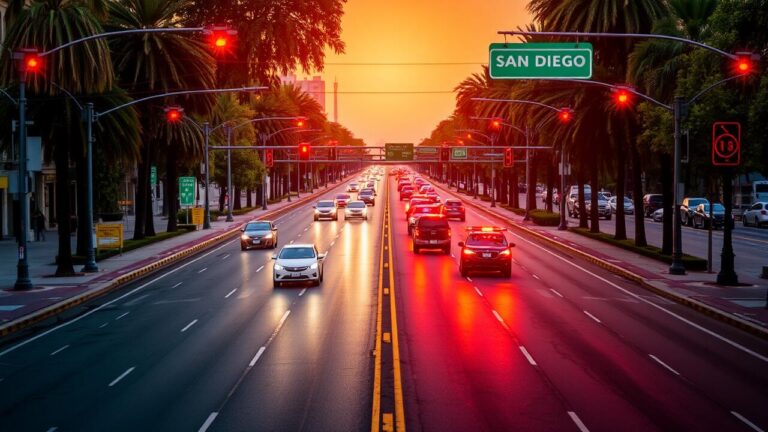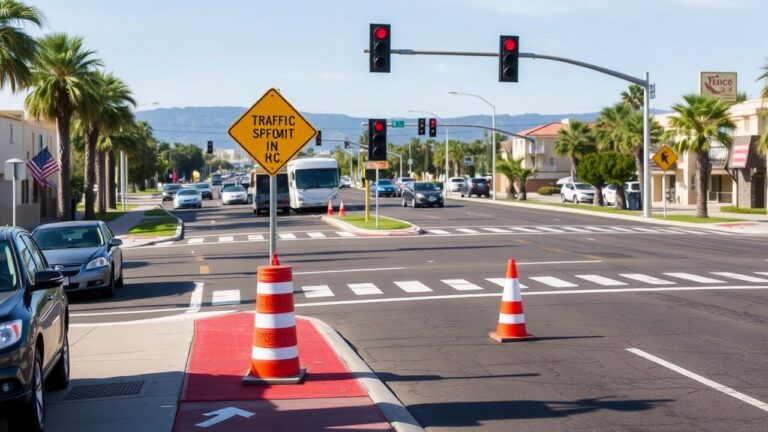Transportation and Infrastructure Updates
The Future of Autonomous Vehicles
Autonomous vehicles—oh, what a whirlwind they bring to the realm of transportation! This isn’t just a simple upgrade; it’s an upheaval, a grand metamorphosis poised to amplify safety, efficiency, and accessibility in ways we’ve only dreamed. As technology marches on unabated, waves of innovation crash upon us from realms like artificial intelligence and machine learning—all orchestrated through intricate sensor systems that fuel the evolution of self-driving cars and trucks. Picture this: automotive titans locking arms with tech wizards, crafting machines adept at maneuvering through tangled urban jungles without so much as a human hand on the wheel. And let’s not forget—the ripple effects stretch far beyond personal rides; think public transit reimagined and freight logistics transformed!
Yet, amid this bubbling excitement lies a mosaic of challenges that complicate the road ahead for widespread adoption. Regulatory red tape looms large—how do we carve out guidelines that secure safety while ensuring accountability? Then there’s the matter of public sentiment—a patchwork quilt where skepticism reigns supreme about trusting these autonomous wonders. Plus, infrastructure must undergo its own makeover to seamlessly weave these high-tech marvels into our already bustling traffic tapestry. As pilot programs spring forth like wildflowers after rain, collecting real-world data will be paramount—not just for fine-tuning technology but also for navigating potential liability minefields lurking in this brave new world!
Current Pilot Programs and Their Challenges
Across the globe, a myriad of cities are diving headfirst into the intriguing realm of autonomous vehicle pilot programs, all with an eye on gauging their safety and efficacy amidst the hustle and bustle of urban life. These ventures are born from collaborations between cutting-edge tech firms and local authorities, paving the way for hands-on trials of self-driving cars in carefully curated environments. Yet, lurking beneath this progressive facade lie formidable challenges. The legal and regulatory landscapes often lag far behind, ill-equipped to tackle the intricate dance that is autonomous navigation—this creates a fog of uncertainty enveloping participants and stakeholders alike. Moreover, public acceptance looms as an essential barrier; lingering worries about safety and reliability continue to cast shadows over these innovations.
Then there’s the labyrinthine task of data collection and analysis—a veritable quagmire! Pilot initiatives must harness advanced technology to sift through mountains of data concerning traffic dynamics, environmental factors, and user interactions. Transforming this deluge into coherent insights can feel like scaling a steep cliff face without gear! And let’s not overlook the technical hurdles tied to ensuring seamless communication between these nascent systems and our existing transportation networks—it’s no small feat. Nonetheless, despite these myriad obstacles standing in their path, pilot programs hold tantalizing potential—they could illuminate pathways toward integrating autonomous vehicles into our diverse urban jungles in ways we’ve yet only begun to imagine.
| City | Tech Partner | Program Duration | Key Challenges |
|---|---|---|---|
| San Francisco | Waymo | 2018 – Present | Regulatory hurdles, public acceptance |
| Pittsburgh | Uber | 2016 – 2020 | Data analysis, safety concerns |
| Los Angeles | Autonomous Stuff | 2020 – Present | Integration with existing traffic systems |
| Shanghai | Baido | 2019 – Present | Public perception, technical reliability |
| Tokyo | Toyota | 2020 – Present | Legal frameworks, data collection challenges |
Challenges Facing Rail Transportation
The rail transportation sector finds itself grappling with an array of challenges that stymie its efficiency and reliability. A crumbling infrastructure looms large as a pressing issue, with numerous rail networks clinging to aging tracks and antiquated systems desperately in need of a facelift. This decay doesn’t just throw a wrench into punctuality; it also raises alarm bells about safety for both passengers and freight alike. Compounding the problem, budgetary constraints often bind the hands of rail companies and public transport authorities, thwarting their efforts to carry out vital upgrades—resulting in an ever-growing backlog of must-do maintenance tasks.
As rail systems expand, safety and maintenance concerns have surged to the forefront. Though derailments and accidents are rare occurrences, when they do happen, they can unleash catastrophic repercussions—both human tragedies and economic fallout. Maintenance practices must adapt swiftly to meet the escalating demands on these sprawling networks. Embracing cutting-edge monitoring technologies could significantly bolster our ability to spot faults early on, averting potential calamities before they unfold. A forward-thinking approach toward safety and upkeep is not merely desirable; it’s imperative for rekindling public trust in rail transportation while simultaneously fostering its growth and sustainability amidst this turbulent landscape.
Addressing Safety and Maintenance Issues
Ah, the intricate dance of safety in rail transportation—an ever-pressing concern that looms larger with each passing day! As our infrastructure grows older and ridership swells, the stakes become even higher. Picture this: regular inspections and maintenance protocols are not merely routine; they are lifelines, crucial for unearthing those sneaky weaknesses lurking in tracks, signaling systems, and rolling stock.
Now imagine a world where advanced monitoring technologies like drones swoop in alongside sensors to catch potential issues before they spiral into chaos—a technological symphony enhancing early detection! And let’s not forget about investing generously in comprehensive training programs for maintenance crews; these unsung heroes need cutting-edge knowledge and skills to tackle emerging challenges head-on.
But wait—it doesn’t stop there! A sturdy reporting system is paramount—it invites employees and passengers alike to voice their safety concerns without hesitation. Collaboration? Absolutely essential among all players involved—government agencies rubbing elbows with private firms—to cultivate best practices for maintenance that actually work!
And then there’s funding—a vital pulse keeping repairs and upgrades alive. Consistent investment isn’t just important; it’s critical! By placing safety and maintenance front-and-center on the agenda, rail systems can elevate operational reliability while nurturing public trust within this sprawling transport network we depend upon every day.
- Establish regular inspection schedules to ensure timely identification of safety issues.
- Implement advanced monitoring technologies such as drones and sensors to enhance early detection of potential problems.
- Develop comprehensive training programs for maintenance crews to keep their skills up-to-date with the latest advancements.
- Create a robust reporting system that encourages employees and passengers to communicate safety concerns without fear.
- Foster collaboration between government agencies and private firms to share best practices in maintenance and safety.
- Secure consistent funding for repairs and upgrades to maintain infrastructure integrity.
- Prioritize public awareness campaigns to educate the community about safety measures and reporting processes.
The Importance of Accessibility in Transportation
Accessible transportation is absolutely vital for ensuring that everyone, especially individuals with disabilities, can navigate the world around them. Yet, this group often grapples with daunting barriers—barriers that make public transit feel like an insurmountable mountain or private transport options seem like a distant dream. Imagine cities embracing designs that champion universal access: low-floor buses gliding through streets, audio-visual announcements ringing out to guide passengers, and stations built with every ability in mind. This isn’t just about getting from point A to B; it’s about empowering people of all abilities to embrace their independence.
But let’s not stop there! Accessibility in transportation infrastructure doesn’t just cater to those facing physical challenges—it extends its arms wide open to elderly folks who may need extra support and families wrangling young children and strollers. When we weave inclusive design principles into the very fabric of our transportation projects, we’re crafting a smoother journey for everyone involved.
Engaging stakeholders means diving deep into community conversations—listening intently as marginalized voices share their unique needs and hurdles. Such investment in accessible transport doesn’t merely enhance system efficiency; it unleashes potential economic participation while elevating quality of life across the board! By prioritizing accessibility, we invite more riders aboard while simultaneously easing dependence on personal vehicles—a dual victory for both urban environments and our planet’s health!
Strategies for Inclusive Design
Inclusive design is absolutely essential when it comes to shaping transportation systems that truly serve everyone—no matter their physical capabilities. It’s not just a checklist; it’s about diving deep into the nitty-gritty of features like building entrances, public transit vehicles, and wayfinding signage, all aimed at crafting spaces that are genuinely user-friendly for individuals with disabilities. But here’s the twist: teaming up with advocacy groups and stakeholders can unlock treasure troves of insights into unique needs. This collaboration paves the way for adaptations that not only boost usability but also ensure equal access across the board.
And let’s talk tech! The infusion of advanced technologies takes inclusivity in transportation design to dizzying new heights. Imagine smart solutions—think mobile apps delivering real-time intel on accessible routes and services—that empower users to navigate their journeys with newfound confidence. Plus, weaving universal design principles into the fabric of infrastructure from day one guarantees that diverse user experiences are supported at every turn. Ultimately, this approach fosters a vibrant sense of belonging and independence within our communities—a goal worth striving for!
Innovations in Freight and Logistics
The freight and logistics sector is surfing a transformative tidal wave fueled by the latest tech innovations, creating ripples that are impossible to ignore. Advanced algorithms and artificial intelligence are not just nudging; they’re flipping the script on route optimization and supply chain management in ways we never thought possible. This seismic shift doesn’t merely boost efficiency—it slashes operational costs with astonishing precision. Armed with real-time data analytics, companies can peer into the future to better forecast demand, pivoting their logistics strategies like seasoned chess players.
And let’s talk about visibility! The Internet of Things (IoT) has burst onto the scene, illuminating every corner of the supply chain and empowering proactive shipment management like never before.
But wait—there’s more! Automation is striding in as a game-changer, turbocharging productivity across this bustling industry. Robotics and automated systems are taking over warehouses, making picking and packing smoother than ever. Meanwhile, autonomous vehicles and drones are being tested for last-mile delivery—a bold step towards speediness wrapped in flexibility. These technological marvels open up exciting avenues to tackle labor shortages while bolstering service reliability.
With these groundbreaking solutions at their fingertips, the logistics sector is poised not only to meet but exceed consumer demands—all while holding steadfastly to high standards of efficiency and reliability. It’s an electrifying time for this dynamic field!
How Technology is Shaping Delivery Services
The fusion of cutting-edge technology with delivery services is igniting a seismic shift in logistics operations across the globe. Picture this: data analytics whirring away, empowering companies to fine-tune routes and turbocharge efficiency, all while slashing time and fuel costs like never before. Customers are now granted a front-row seat to their deliveries through real-time tracking systems—talk about transparency! This surge in visibility not only boosts satisfaction but also transforms the customer experience into something seamless.
But wait, there’s more! Enter drones and robotic delivery vehicles—these futuristic marvels are rewriting the script on how goods journey from point A to point B. In bustling urban landscapes where traffic can feel like an endless maze, these innovations promise to revolutionize last-mile delivery. And just when you think it can’t get any better, artificial intelligence steps onto the scene, skillfully predicting demand trends that allow businesses to pivot their inventory and distribution strategies with finesse. This wave of technological evolution doesn’t merely enhance service reliability; it stirs up fierce competition within the logistics realm—a thrilling race toward excellence!
The Economic Impact of Transportation Infrastructure
Investing in transportation infrastructure isn’t just a mundane necessity; it’s like throwing a match onto the kindling of economic growth, igniting a fire that can transform entire communities! Picture this: efficient transportation systems whittling down travel time to mere minutes, weaving connections tighter than ever before, and slashing costs for businesses who are eager to thrive. When infrastructure gets an upgrade—think sleek roads, sturdy bridges, and reliable public transit—it doesn’t just attract shiny new industries; it nudges existing ones to stretch their wings and soar. Job opportunities? They blossom like wildflowers in spring!
But wait—there’s more! A robust network of transport doesn’t only fuel commerce; it stirs community development into action. With enhanced accessibility comes the sweet scent of rising property values and dipping unemployment rates. The effects ripple outward—a chain reaction where innovation bubbles up from every corner, where entrepreneurship finds fertile ground to take root. Communities that put infrastructure at the forefront aren’t merely keeping pace; they’re gearing up for an exhilarating race in the competitive economic arena. The outcome? A skyward trajectory toward prosperity that benefits residents and businesses alike!
Analysis of Job Creation and Local Growth
Investing in transportation infrastructure isn’t just a line item on a budget; it’s the lifeblood of job creation and economic vitality within local communities. Picture this: upgraded transport networks come alive, sparking trade like wildfire, broadening access to vital resources, and weaving together businesses in ways previously unimagined. With each new project launched, temporary construction jobs spring forth—yes!—but that’s merely the tip of the iceberg; these initiatives blossom into permanent roles for operations and maintenance once everything is up and running. This vibrant cycle reveals why prioritizing transportation upgrades should be at the forefront of any economic development game plan.
But wait, there’s more! Enhanced transportation systems aren’t just about keeping things moving—they’re magnets for new businesses eager to set up shop. Companies hunt for locales with dependable roads, railways, and ports that can streamline their supply chains like clockwork. The magic lies in how efficient transport infrastructure slashes operational costs while supercharging logistics for savvy enterprises. Communities willing to invest in modernizing their transport framework are poised to unleash a ripple effect—a surge in overall employment paired with an uptick in local investment—that cultivates a thriving economic ecosystem built for sustainability and growth.
Conclusion
The realm of transportation and infrastructure is in the midst of a whirlwind transformation, brimming with potential to boost efficiency, elevate safety standards, and broaden accessibility. As we hurtle forward into an era rich with technological breakthroughs, the imperative to weave these innovations seamlessly into our systems looms larger than ever. Tackling the intricate challenges posed by rail networks and freight logistics demands a concerted effort—a symphony of collaboration among stakeholders aimed at nurturing sustainable growth.
Looking ahead, initiatives must embrace inclusive design principles as their cornerstone; this ensures that no one is left behind in reaping the rewards of improved transportation. Pouring resources into infrastructure isn’t just about fostering job creation—it’s a lifeline for local economies too. By honing in on these vital dimensions, communities can eagerly anticipate a future where their transportation network becomes not only more interconnected but also acutely attuned to their needs.







